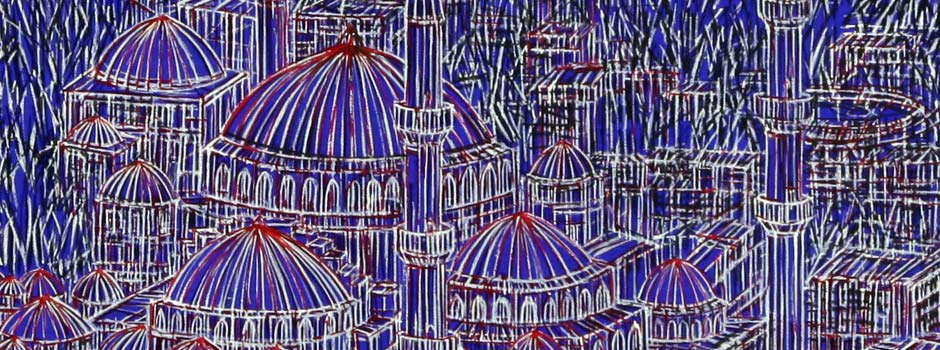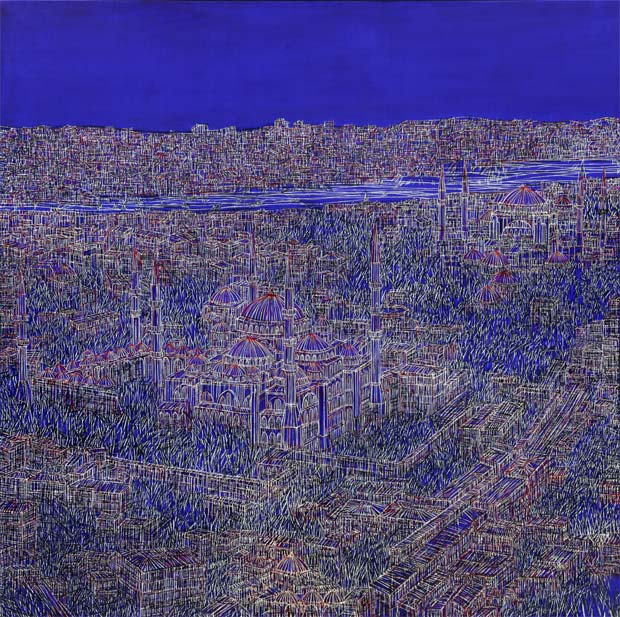
Devrim Erbil’s Solo Exhibition at Dubai’s Renowned Artspace Gallery
Feb 19, 2013 Exhibition
Devrim Erbil was born in Uşak in 1937. He was enrolled in the painting department of the State Academy of Fine Arts in İstanbul in 1955. He studied first in the academy`s Gallery section under Halil Dikmen and later in the studio of Bedri Rahmi Eyüboğlu. In 1959 he founded the “Soyutçu 7`ler†(Seven Abstractionists) group. After graduating from the academy`s painting department he joined academy (in 1962) as a teaching assistant, undertaking duties in the studios of Bedri Rahmi Eyüboğlu, Cemal Tollu and Cevat Dereli.
In 1963 he founded the Mavi Grup (Blue Group) in association with Tülay Tura, Altan Gürman, Adnan Çoker and Sarkis. In 1965 Erbil was awarded and art scholarship by the Spanish government and began studying in Madrid and Barcelona. He continued his studies in Paris and London. He was awarded the title “State Artist†in 1991.
Erbil`s works have been shown frequently in group exhibitions in Turkey and abroad. Works by the artist have been selected for the collection of the state museums of painting and sculpture in Ankara, Ä°stanbul and Ä°zmir. Works by him are also at the Museum of Modern Art in Bucharest, at the Banja Luka Umjetnicka Gallery in Bosnia and Herzegovina, in Ben and Abby Grey Foundation Collection, the Ankara National Library Collection, and in a number of public and private collections in Turkey and abroad.
 Devrim Erbil / Blue Night in Istanbul, oil on canvas, 140X140 cm. Code 28-Ocak, 2013 / Courtesy of ARTSPACE Dubai
Devrim Erbil / Blue Night in Istanbul, oil on canvas, 140X140 cm. Code 28-Ocak, 2013 / Courtesy of ARTSPACE Dubai
In Devrim Erbil’s painting, the process of artistic creation and the integrity of the artwork is first interrogated, then stabilized and finally affirmed, until the time when the work reveals itself in its fragility once more and invites reason to give it new form. After graduating in 1959 from the painting department of the State Fine Art Academy, the precursor of Mimar Sinan University, Erbil won a number of international and national awards. He received the title of professor at the academy in 1981 and became chairman of the painting department four years later. In 1988, he was appointed chairman of the Yildiz University Fine Arts Department; in 1990, he became Deputy Dean of the Mimar Sinan University Fine Arts Faculty. In 1991, he was awarded the title of “State Artist.â€
Devrim Erbil has played a crucial role in the development of modern Turkish painting. He also served in key administrative and academic positions, impacting the development of a generation of young Turkish painters. It therefore seemed appropriate to present a more in-depth article on his painting. The excerpts were chosen to indicate Erbil’s place in the tradition/modernity divide in painting and his assessment of the modern trends in Turkish painting and their prospects.
“Will to diversify†is the key element of Erbil’s artistic production, a characteristic that stems from the painter’s successful “self-encounter.†The integrity that is a guarantor of an original identity stems from the spontaneity associated with the process of chain production in Erbil’s work.
On the other hand the multi-dimensional aspect in Erbil’s work can be pointed out as “The desire to question the losses incurred through our jet-style living by establishing a distance from one’s feelings has been the greatest support for Erbil, who made it his principle to view his proposed language of expression with a critical eye. For this reason, the representation of the object has always been a pretext for ‘seeing’ the painting.â€
The interrogation of the medium of expression (the canvas) and the object of representation is a constant in Erbil’s work. “The precarious existence of illusion addresses our imaginative universe, as long as it reserves the right of dissociation from the object of which it is the form.â€
Thus, in Erbil’s painting, the process of artistic creation and the integrity of the artwork is interrogated, stabilized and affirmed, up until the time the work reveals itself in its fragility once again and invites reason to tie it together. Since Gilles Deleuze and postmodernism, rising skepticism about the coherence of the world and the ensuing malaise has been expressed by deforming the figure into the “figure-like,†which, “signifies the figure unable to come to terms with the authentic form.†Devrim Erbil’s figures don’t belong to the category of the “figure-like.†Instead, “Nature [for Erbil] is a cosmic power waiting to engage in dialogue with itself, domestic eternity waiting to take its place on the canvas.†Erbil “leaves illusion at a delicate point,†and that “the purpose is never complete abstraction from the accepted sign system; painting, at least in one respect, has to be a mirror cast on the world.â€
The use of lines for painting may be Devrim Erbil’s main characteristic. Erbil states the function of the line thus: “The line is actually an abstraction of the human mind. The line doesn’t exist in nature, whereas it has been an indispensable part of all that depends on abstraction. For the line is the place where forms intersect and differentiate themselves from space.†Noting that although the line had been the main part of any painting until modernity, it wasn’t used for any purpose except the delineation of the contours of an object, Erbil states that while his use of lines was influenced by its place in art history, it was more of a personal predilection, one that manifested itself in his paintings when he was 14-15 years old. He points out his agreement with Paul Klee’s statement that “our goal was to make the invisible visible,†adding he accepts Klee as an important master.
Located at the DIFC Gate Village in Dubai, ArtSpace was launched nine years ago by Managing Director Maliha Al Tabari, a BFA graduate with a minor in art history from the Otis College of Art and Design in California, and the Ringling School of Art and Design in Florida, the gallery is the forerunner in the promotion of contemporary Middle Eastern art in the country. Backed by Maliha’s family and independent collectors and investors, Artspace has championed the works of some of the Middle East’s most prolific and respected artists. The gallery was born from the gaping need for a platform to celebrate Middle Eastern Art. “Ever since I returned to Dubai, I noticed the lack of contemporary art, and was compelled to promote it in the country,†says Maliha. Managed by qualified and professional staff, all of which have rich backgrounds in the worlds of art and art consultancy, Artspace offers collectors access to some of the finest art and artists from the region.
Comments
Add a comment